First, I do not really care for sanding. As a professional woodworker, finding the fastest, easiest, most efficient way to bring wood to a prepared finish for stain and lacquer was a never ending, but very important goal.
With lots of discussion about removing char, fitting notches etc, both requiring sanding and filing, I thought I'd see what others do and use.
These are pics of most of my stuff, some of which is used on plastic models too.
Aluminum sanding blocks with an UHMW face, using PSA paper - I like the handles on these and the sandpaper changes out easily. I have some somewhere made of regular extruded aluminum, but couldn't find them. The paper doesn't remove as easily.
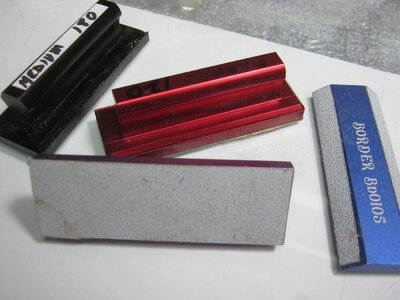
Various burs for the foredome and dremel type tools. These are permagrit type carbide grit, but I have some diamond one's as well.
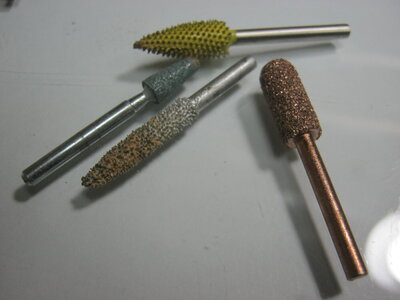
More dremel types, drums using sandpaper (bottom right), drums with a metal band and permagrit material (top), disks in various grits and one with a foam backing and hook and loop attachment (left). I can punch the disks out of hook and loop sheets or 5" disks I use in the woodshop, or buy them pre-made.
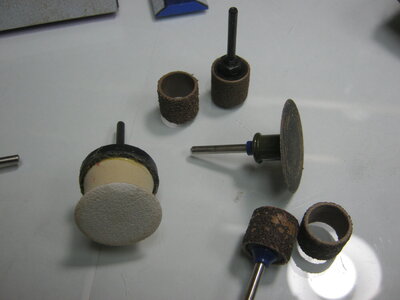
Sanding blocks and sticks made from wood scraps and strips using PSA paper. Can be made with square or beveled edges, edges with no paper in them (safe edges), narrow, wide, long, even curved or shaped, such as when sanding the inside of a hull.
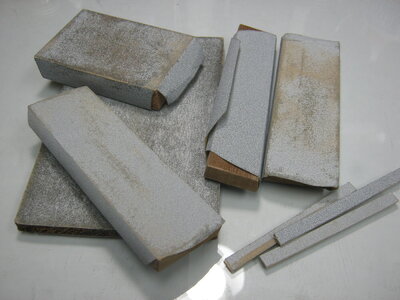
Sanding sticks of all kinds. The hobby type ones I us a lot on plastics and for final finish on wood, but for shaping wood I go to Sally Beauty supply and get them. They are less expensive and come on wider and a bit longer sizes, with somewhat coarser grits for initial shaping use. Can also find them at Walgreens.
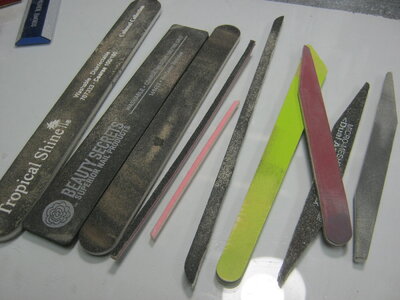
Larger blocks, for fairing in and flattening. One is permagrit in two grits on one block. The other is just a block of hard felt with PSA paper stuck on it. The paper changes out easily.
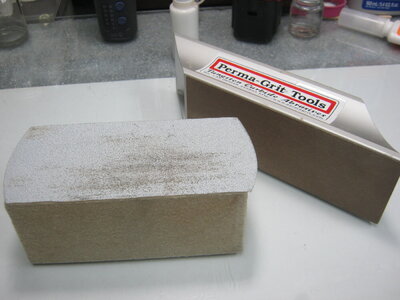
Various files - from top down - Perma grit, two grits, 5 shapes, made my own handles, not fancy but functional, one groove for fine, two grooves for medium. Next three are different diamond files, came in sets of 5 or 6 in each type and various grits. Needle file, some came in sets, some as singles, have several of them in various shapes. 4" machinist's files, in mill and bastard teeth and in flat, half round, round, square and triangle shapes. A couple flat ones have "safe" edges. The last came with nice handles, but I prefer each file having it's own so I don't have to change them out. They are nice to put in my "travel" tool box though.
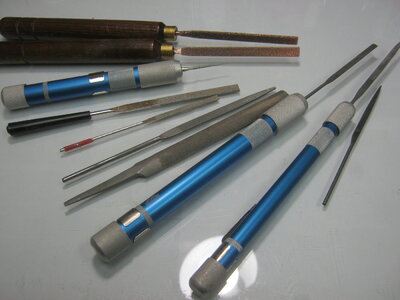
Some od balls. Dowels wrapped with PSA paper, plastic foam sticks covered with grit (Flex-I File), an aluminum handle with a square metal pad on the end, uses PSA paper stuck to it for tiny, hard to access spots. Have some in round and triangle too.
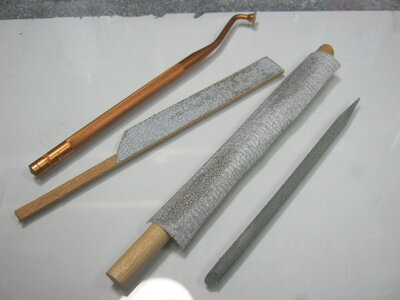
The papers I use. From 80 grit to 320 grit. I get them in rolls for use in the woodshop. For PSA, about $26.00 for a roll of 100 5" disks, or rolls 4 1/2" wide by 10 meters for about $18.00. Every grit you can think of. I also use hook and loop papers in the woodshop, but more limited use in the model cave.
Also just plain sheets, with thin or heavy backings and different grit types.
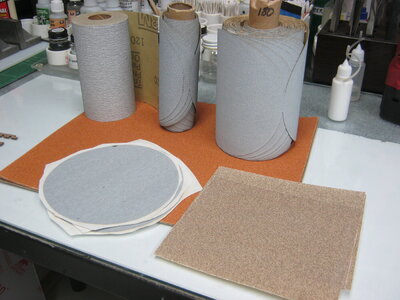
I sometimes just stick a PSA on the glass work surface and use it to flatten or straiten parts, like a big grinding plate. This one has a hole in it from where I punched out a disk for sticking on a sander.
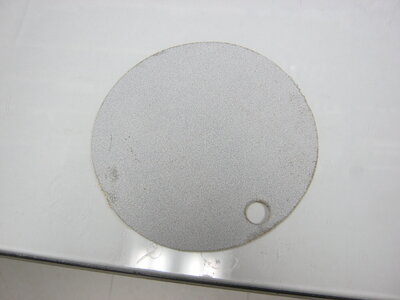
And for heavier work, this little 5" disk sander, variable speed. Uses the same 5" disks I use in the shop.
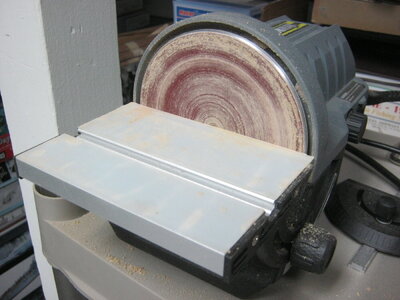
I know I've missed a few that I have laying about, but you get the idea. I have the advantage of having a lot of stuff out in the woodshop too. I built a thickness sander that utilizes my wood lathe for power, a couple scroll saws, band saws, Mini table saw etc. but that's a different path.
Please post your ideas, tools, equipment and methods here too. I love to see how others manage tasks.
With lots of discussion about removing char, fitting notches etc, both requiring sanding and filing, I thought I'd see what others do and use.
These are pics of most of my stuff, some of which is used on plastic models too.
Aluminum sanding blocks with an UHMW face, using PSA paper - I like the handles on these and the sandpaper changes out easily. I have some somewhere made of regular extruded aluminum, but couldn't find them. The paper doesn't remove as easily.

Various burs for the foredome and dremel type tools. These are permagrit type carbide grit, but I have some diamond one's as well.

More dremel types, drums using sandpaper (bottom right), drums with a metal band and permagrit material (top), disks in various grits and one with a foam backing and hook and loop attachment (left). I can punch the disks out of hook and loop sheets or 5" disks I use in the woodshop, or buy them pre-made.

Sanding blocks and sticks made from wood scraps and strips using PSA paper. Can be made with square or beveled edges, edges with no paper in them (safe edges), narrow, wide, long, even curved or shaped, such as when sanding the inside of a hull.

Sanding sticks of all kinds. The hobby type ones I us a lot on plastics and for final finish on wood, but for shaping wood I go to Sally Beauty supply and get them. They are less expensive and come on wider and a bit longer sizes, with somewhat coarser grits for initial shaping use. Can also find them at Walgreens.

Larger blocks, for fairing in and flattening. One is permagrit in two grits on one block. The other is just a block of hard felt with PSA paper stuck on it. The paper changes out easily.

Various files - from top down - Perma grit, two grits, 5 shapes, made my own handles, not fancy but functional, one groove for fine, two grooves for medium. Next three are different diamond files, came in sets of 5 or 6 in each type and various grits. Needle file, some came in sets, some as singles, have several of them in various shapes. 4" machinist's files, in mill and bastard teeth and in flat, half round, round, square and triangle shapes. A couple flat ones have "safe" edges. The last came with nice handles, but I prefer each file having it's own so I don't have to change them out. They are nice to put in my "travel" tool box though.

Some od balls. Dowels wrapped with PSA paper, plastic foam sticks covered with grit (Flex-I File), an aluminum handle with a square metal pad on the end, uses PSA paper stuck to it for tiny, hard to access spots. Have some in round and triangle too.

The papers I use. From 80 grit to 320 grit. I get them in rolls for use in the woodshop. For PSA, about $26.00 for a roll of 100 5" disks, or rolls 4 1/2" wide by 10 meters for about $18.00. Every grit you can think of. I also use hook and loop papers in the woodshop, but more limited use in the model cave.
Also just plain sheets, with thin or heavy backings and different grit types.

I sometimes just stick a PSA on the glass work surface and use it to flatten or straiten parts, like a big grinding plate. This one has a hole in it from where I punched out a disk for sticking on a sander.

And for heavier work, this little 5" disk sander, variable speed. Uses the same 5" disks I use in the shop.

I know I've missed a few that I have laying about, but you get the idea. I have the advantage of having a lot of stuff out in the woodshop too. I built a thickness sander that utilizes my wood lathe for power, a couple scroll saws, band saws, Mini table saw etc. but that's a different path.
Please post your ideas, tools, equipment and methods here too. I love to see how others manage tasks.


